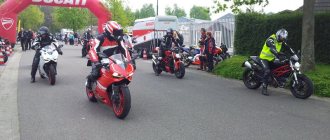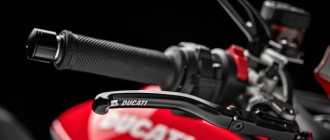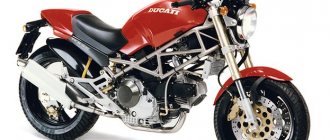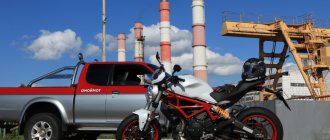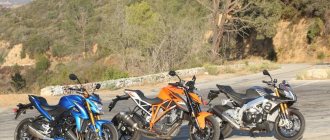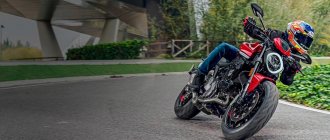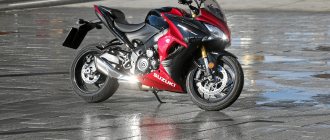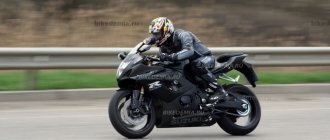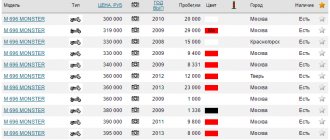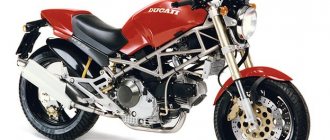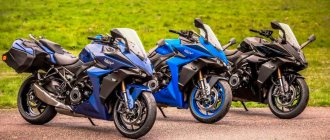It turns out that I don't like inline-fours, even though I've owned quite a few bikes with those engines. I especially don’t like the behavior of fours in the city, so when choosing a city motorcycle, it would be logical to pay attention to other types of engines. The riding style is streetfighter, so you need an appropriate motorcycle, a city street bike with good dynamics and handling. I like sport twins the most, so it's logical to start with them. In fact, there are only two companies that make decent sport twins, Ducati and KTM, and both manufacturers have city bikes in their lineup. Ducati has the well-known Monster, KTM has the SuperDuke. Let's start with the monster.
So, Ducati Monster 1200.
This type of motorcycle is familiar to me, and I am also familiar with Ducati products first-hand. So I won’t do a review “from scratch”, but I’ll just try to note what distinguishes this motorcycle from its classmates, what features it has, and most importantly, how suitable it is for the role of a city motorcycle for every day, taking into account the riding style, Certainly. The line of Monsters is quite large, but I’m only interested in the older model; I’ve already outgrown the smaller ones a little, it’s not interesting.
Appearance and design
Monsters have been made for a very long time, almost 20 years. Since then, Ducati has changed the design of these motorcycles many times, but they still have a very distinctive look and are perfectly recognizable. It cannot be confused with anything. So it is with the Monster 1200, a typical “monster” design, cage, minimalism, cantilever rear suspension, that’s all. The design is nice, but other than the fact that it is a Monster, there is nothing special to say about it.
Structurally, this is also a typical Monster. Twin, short wheelbase, complete absence of plastic and fairings, classic front and cantilever rear suspension, regular street steering wheel. All electronic systems typical for modern top-end motorcycles are also present, but without any special frills. The motorcycle is quite light. This engine is familiar to me; it’s about the same one on my Multistrada.
Convenience and ergonomics
The fit is typical for a street style.
There is nothing specific about it, it’s the same as on many other motorcycles, and in general it’s exactly the way it should be, at least for me. The motorcycle feels very small and short, much smaller than you would expect from a more than liter street bike, but for the city this is just good. The only criticism is that the rear part of the tank is too wide, this makes it a little difficult to wrap your knees around the tank. It’s unusual, and in my opinion it makes it a little difficult to feel the motorcycle, but you can get used to it. Otherwise, no complaints. The saddle is not the most comfortable, but it is noticeably plump and soft. For the city, he sat down and forgot; in a long distance he may not show his best side. Overall, the saddle is better than average and more than satisfactory. The steering wheel is comfortable, exactly what you need, and exactly where it should be. Remote controls... well, ducati. The usual remote controls for this company, with normal, but sometimes questionable ergonomics. But there is a remark - the quality of the buttons and levers is noticeably lower than that of the Multistrada, it feels like they were trying to save money. The clicks are not very clear, they wobble a little, this does not interfere, but you expect something a little different from a top model. Moreover, there are no problems with this on the Multistrada, which means they can. The grips are a little thin.
The instrument panel is electronic and color, it looks like it is transflective. Everything looks good, but the tidy itself is small and quite minimalistic. In general, it’s quite enough for the city, it’s not annoying at all, but it’s far from delightful. The fuel gauge, as is typical for Ducati, shows some kind of garbage. I stopped at a gas station with the last sector blinking for a long time (it was already red), filled up four liters, the gauge showed half a tank. I wasn’t particularly surprised, it was Ducati, but rather surprised that they never fixed these bugs. You can get used to it, but maybe this is a feature of a particular specimen.
Starts with a key. It's bad to be like this.
There is no wind protection, none at all.
Engine and gearbox
As I already said, this engine is quite familiar to me. It's a good big-displacement sport twin that can be quite fun in the right modes. From the Multistrada in “sport” mode it practically turns into a sportbike. It also has some peculiarities - little low end, which is a little unusual for a 1200 cc twin, and a not very smooth traction characteristic in the middle of the range, there are dips and pick-ups. It actually adds character and is quite fun, but it's something to keep in mind.
Oddly enough, on the Monster this engine turned out to be noticeably smoother. There is enough of it in all modes and in all gears, there is always a reserve under the handle, or almost always. As is typical for a cubic twin, sometimes you simply forget what gear you're in and forget to shift altogether, suddenly finding yourself in, say, fifth when you were sure it was third. And it happens the other way around. The main advantage of the twin is the fatty middle, very comfortable in the city, which is completely present here.
Even in sport mode (and I almost never use the others), the engine feels smoother and not as harsh as in the heavier Multistrada. Most likely the problem is in other electronic throttle settings; on the Multistrada in sports mode the throttle becomes very sharp, but this is not the case here. Everything is a little smoother, neater, and a little more stretched out. If you think about it - ideal settings for the city, well done, it’s really very convenient.
The gearbox is a regular Ducati gearbox, about the same as on the Multistrada, quite clear and quiet, but it doesn’t have any memorable features. As well as there is no quick. On the tested motorcycle there were big problems with the neutral, but most likely this is a feature of this test specimen; the box was a little wobbly.
Vibrations are present in the second half of the tachometer, normal, such large high-quality vibrations of the Ducati Twin. There are noticeably more of them than on the Multistrada with the same engine, but less than on the S4R. In the city, these vibrations do not cause inconvenience, in some places they are even pleasant, this is not the minor itch of an inline four. In a long distance, they can probably be annoying.
The sound is typical for this engine – tractor-like. And of course, the usual additional sounds for Ducati, all sorts of clicking, smacking, rattling and the rest of the set. But at least the clutch is wet and doesn’t rattle.
The clutch itself works perfectly, I would even say – exemplary. This is typical of this company's hydraulic clutch. The clutch settings are also urban, a little smoother than sports. The information content is excellent.
Brakes
As expected from a top-end Ducati model, the brakes are Brembo, and top-of-the-line ones too. They work great and slow the bike down really well. But as is typical of road-going Ducatis, the brakes are a bit on the stretch side and aren't as sharp as, say, the S1000R. But a little sharper than on the Multistrada. In my opinion, these are ideal settings for the city, but not for the track.
Of course there is a bite, but it’s average, you quickly stop noticing it. Combibrake, ABS - everything is typical for a top model, and it works great. When braking, the motorcycle holds its trajectory like a glove, even better than most sports.
The ABS is set to respond rather late, so the motorcycle performs emergency braking with a joyful squeal, drawing the front wheel, and without deviating even a millimeter from the trajectory. Great. But what’s even more wonderful is that he can do almost the same thing with the ABS disabled: the front wheel is blocked, but he doesn’t even think about falling. I have not yet seen this kind of behavior on other motorcycles, excellent braking stability. I don't even know how they achieved this.
Stoppie doesn’t do this, although I didn’t notice any pronounced antistoppy work. On the Multistrada, the anti-stop work is felt very well, but on the Monster it somehow dissolves into the general slowdown. But it is obvious that anti-stoppi also works, otherwise the motorcycle would have been standing on the front wheel for a long time. I didn't even check the rear brake, it's a sin. However, most likely nothing interesting, as usual.
Overall, these are ideal brakes for a city motorcycle. Neither subtract nor add.
Pendants
Stiff, almost sporty streetfighter suspension.
They have a range of adjustments, but no matter how you adjust them, you won’t get a classic motorcycle, or a sportbike either. The suspensions are exactly streetfighter, a step more relaxed than sports ones. Just like everything else, this is almost ideal for the city, this is exactly the kind of suspension that a real street fighter should have.
There's not much else to say about the suspensions; they work so well and so close to expected that you very quickly stop paying attention to them altogether. They're just doing their job.
The pendants are very energy-intensive, I couldn’t break through them, although I tried. They take on everything you throw at them, but transfer most of it to the steering wheel and butt. The trajectory is not lost.
In fact, these are classic suspensions brought to perfection, fully tuned and tuned, and then slightly relaxed to suit the purpose of the motorcycle. If you tighten them with the adjustments, then you can go to the track. It won't be ideal, but they won't let you down.
Simply put, the suspension is almost perfect, taking into account the purpose of the motorcycle and riding style. Further they can be improved only with electronics, that is, made active. But in the city this is not really necessary.
Controllability
Streetfighter from the Chamber of Weights and Measures.
Small, nimble, rolly, clinging to the road, and very willing to maneuver. The handling is almost sportbike-like, but at the same time a little relaxed, as needed for the city. The bike is just as sharp as it needs to be off the track. It can also be a lot of fun on the track, but it won't be in the front row. It holds its trajectory well in corners.
Just like with the suspension, you simply stop thinking about handling - the motorcycle easily does everything you ask it to do, but doesn’t bother you. In the city there is almost always a margin of controllability.
Even if I wanted to, I have nothing to complain about here; this is exactly the kind of behavior I expect from a top street fighter. On the highway, these features will be a little annoying; when traveling, such agility is not needed.
Operating modes
They exist, but I only tried sports.
I repent, I am a sinner. However, I most likely won’t need other modes, except perhaps rain mode, just in case. Switching modes like on a Ducati, through the menu, is infuriating. The modes seem to be configurable, there is not only the engine, but ABS, TC, maybe something else. You can turn off the electronics and play around, but as usual for Ducati, you have to go into the menu to do this, and this is not very convenient to do on the go.
This motorcycle has a rather narrow purpose, it is purely urban, and it does not need to be a werewolf. It seems to adapt to beginners too - this is not a motorcycle for beginners. So, in my opinion, it simply doesn’t need any kind of advanced mode switching, and what it has is quite enough.
You must understand that even in sports mode it will not become a sport, and not because it cannot, but because it does not need it. Everything will be clear, fast, fun, but slightly smoothed out, and smoothed out clearly on purpose. But he won’t become a road worker in the most relaxed mode either. It will remain a tough streetfighter, just a little more comfortable and smooth.
City
Well, that's his element.
The geometry of the motorcycle is close to ideal for urban conditions. Small, short, the steering wheel is quite narrow, the landing is urban. The bike feels much smaller than you'd expect from a liter-plus serious street bike, which is a strange and wonderful feeling.
Maneuvering in a traffic jam, in traffic of any density, sudden changes in lanes and all this is done literally with a flick of the mind, very easily, very simply and completely without any stress. But at the same time, without the slightest hysteria and harshness characteristic of many other street fighters.
All this is complemented by a twin, which in urban modes can be considered almost endless. What’s good about twins of this kind in city driving is the instant transition from quiet driving to sharp acceleration, just by twisting the throttle a little. You don’t have to think too much about what rpm you have, what gear, what speed, there’s almost always enough dynamics. And all this is fast, but not abrupt, very easy to control. Four-cylinder in-line engines do not allow such freedom; before such an engine begins to show itself, it must be revved up properly, and this involves driving in lower gears, which is tiring and leads to increased consumption. With a twin you don’t need this, you drive calmly in comfortable mode, the situation changes, and now you’ve jumped into the vacated gap, after which you continue to drive just as calmly. Even triples do not provide such opportunities; they are rather something in between.
Similarly with the brakes, at any moment you can get a deceleration of any intensity, which is very easy to control due to the slightly extended reaction. There is no excessive harshness, you slow down exactly as you want (and not as the motorcycle decided). At the same time, the suspensions absorb more or less everything that can be encountered in a city with relatively good roads, such as Moscow, but you have to be prepared for the fact that you can get a decent blow to your hands and ass. The motorcycle does not lose its trajectory under any circumstances, even difficult ones.
The result is an extremely agile bike in the city that rivals any other street bike, even the S1000R, but is also very positive and not at all annoying. It doesn't impose any driving style (unlike in-line fours) and is ready to do anything at any time. Or don't if you don't want to. The feeling is that first Ducati assembled the most productive sports motorcycle, and then, very carefully and carefully smoothed out all the sharp corners, making it exactly a city bike. Yes, it is not track-oriented in nature, and on the track it will not have enough sharpness and precision. But nothing that could be useful in the city was lost, but deliberately preserved.
Of course, this did not make him a simple road worker, not even close. The old Monsters were like that, quite smooth road runners with a touch of sportiness. This one is radically different, it’s a sport with slightly smoother reactions, very balanced and actually very fast. No "wow!" This Monster does not, unless of course you have experience with top liters. This is simply a tool perfectly tuned to the city, which is easy and pleasant to use. It seems that you are not going so fast, but this only seems due to the smoothness of the process itself. In fact, I can ride it faster than any other motorcycle I've ever ridden in the city. And all this without the slightest stress.
But don’t look for crazy drive in this motorcycle, it won’t give you that. His pleasure is lightness, ease in everything. This can be a minus, if you take the street for night shooting, you will most likely ride this Monster in the same way, but there will not be such an adrenaline rush. But these shots through empty streets are not exactly city driving.
Route
What is a plus in the city can become a minus on the highway. A short wheelbase, lack of wind protection, stiff suspension, rather short gears - all this slightly limits the Monster on the track. Long shots along an empty road are not his thing. He can, but it's just not his element. Vibrations will begin to interfere, the short wheelbase will make it a little unstable at high speeds, irregularities will throw it off the trajectory, and so on. Nothing special, but you won’t get the same pleasure as in the city. But there is one interesting nuance. Despite the fact that there is no wind protection, the shape of the headlight (and anything else there) is chosen so that the air flow that hits the chest and helmet grows much slower than the speed. Surprisingly, even at 180 it practically doesn’t blow away, that is, your hands don’t experience additional stress, and you don’t want to lie down on the tank. Despite the fact that there is nowhere to lie down - the motorcycle is short, and if you bend down, you are actually looking at the headlight. But serpentines, turns, and other bottlenecks are just his thing, and the less space, the better he will perform. So he can do it on the highway, if necessary, and even better than one might expect. But this is not a sport-tourist. He will want to go back to the city.
Long-Range
Only if there are no other options. In principle it is possible, but nothing more.
Bad roads and soil
Are you seriously? No, well, you can crawl, the motorcycle is light, but this is already a mockery. It will be about the same as in sports, a little better due to a more elastic engine. And the plastic won’t rattle – there’s simply nothing to rattle with.
Summary
Ducati made an almost perfect urban tool.
Not a rocket, but a tool, ready to do whatever you ask in the city. Fits my riding style perfectly. It costs, if memory serves, one and a half to two million, depending on the version. In my opinion, it is a little expensive for such a specialized motorcycle. And that's the problem. For that kind of money I want more versatility. The S1000R is noticeably cheaper, more dynamic, and maybe just as good. Although it is much more tiring.
Triumph is next.
If we talk about electronics
Speaking of electronics, the Ducati Multistrada 1200 S is equipped with 1299 Panigale equipment, including an IMU (Inertia Measurement Unit) and a 9.1 M1 anti-lock braking system from Bosch, which takes into account the angle of the motorcycle. The IMU combines the functions of a gyroscope and an accelerometer and corrects the motorcycle's position on the road, taking into account tilt, movement and yaw. This data includes DWC and DCL systems. The DWC system reduces front wheel lift during fast acceleration (reducing torque) and is eight-step adjustable (one being the smallest impact, 8 being the largest). On the road, the front wheel lift control system seems a little too fancy, but it's nice that Ducati engineers are bringing racing technology to the street bikes. The DCL system is a cornering lighting technology. The IMU unit works perfectly in tandem with the Skyhook suspension, as well as ABS. Cruise control is now standard, and heated grips are an optional extra.
Regarding the braking system of the Ducati Multistrada 1200
As for the braking system, both Ducati Multistrada 1200 models use Brembo monoblock calipers. However, the S model gets 10mm larger cross-drilled brake discs to better suit the M50 racing calipers. The stopping power of both systems has been enhanced with a sports radial master cylinder at the front and a 20mm larger disc at the rear. The braking systems work in full accordance with the manufacturer's claims, and the ABS system is so effective that there is no point in turning it off.
Ducati Multistrada suspension settings
The suspension benefit is the inverted fork, which further reduces the coefficient of friction, and the stroke length is 170 mm. The Multistrada 1200 S model is equipped with a special sensor that records the movement of the suspension. The ECU records this data, as well as data from the IMU, to modify the damping force based on riding conditions. Suspension settings can be adjusted to five settings (softest, softest, medium, hardest, hardest), as on the 1299 Panigale S. The driver can also choose from a variety of shock absorber preload settings (single ride, ride with passenger and/or passenger, on-screen corresponding colored icons appear). The servo drive comes into operation and regulates the tension of the springs. The Ducati Multistrada 1200 is equipped with an easily accessible non-hydraulic adjustment knob. Fork load settings are adjusted in the traditional way: using a wrench.
Display Ducati Multistrada 1200
Display of the Multistrada 1200
The Ducati Multistrada 1200 S is equipped with a large color display that conveys all the operating conditions, while the standard model has a simpler LCD screen. It’s a pity that the screen is not touch-sensitive; its controls are located on the steering wheel. At first the menu seems complicated, but once you understand the principle, everything becomes elementary. Of course, on such an expensive car I would like to see a higher-quality display, rather than mosaic letters and icons. Other nice touches include a 12-volt outlet located next to the display and a USB port under the rear seat.
